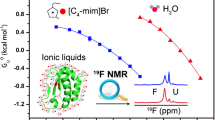Abstract
Stabilization of the monomeric form of insulin (In) under condition of low pH has been a recent challenge. This research aims to reveal the effect of a series of 1-butyl-3-methylimidazolium-based ionic liquids (ILs) on the stability of In dissolved in highly acidic solution (pH 2.0). Differential scanning calorimetry was applied to assess the thermal stability of In in the presence of these ILs. In addition, we monitored the IL-induced changes in the In secondary structure using Fourier transformed infrared spectroscopy. The peak of In thermal denaturation was shifted to higher temperatures in the presence of the tested acetate, trifluoroacetate and dicyanamide salts. At the same time, chloride and thiocyanate ILs had no effect on the thermal stability of the insulin, while the tricyanomethanide salt slightly destabilized the protein. The change in the In conformation affected not only the position but also the sharpness and the shape of the transition peak. As a whole, those ILs which were able to preserve or enhance helical structure of In produced stabilizing effect and those which stimulated the formation of unordered and random-coiled structures deteriorated its thermal stability. No aggregation of In in the presence of the imidazolium-based ILs was observed under the tested acidic media.




Similar content being viewed by others
References
Huus K, Havelund S, Olsen H, van de Weert M, Frokjaer S. Thermal dissociation and unfolding of insulin. Biochemistry. 2005;44:11171–7.
Brange J. Galenics of insulin: the physico-chemical and pharmaceutical aspects of insulin and insulin preparations. Berlin/Heidelberg: Springer; 1987.
WHO media centre. Diabetes. Fact sheet. World health organization. 2015. http://www.who.int/mediacentre/factsheets/fs312/en/. Updated Jan 2015.
Gualandi-Signorini AM, Giorgi G. Insulin formulations—a review. Eur Rev Med Pharmacol. 2001;5:73–83.
Brange J, Langkjær L. Insulin formulation and delivery. In: Sanders L, Hendren W, editors. Protein delivery: physical systems. New York: Plenum Press; 1997. p. 343–410.
Al-Hallak K, Sarfraz M, Azarmil S, Roa W, Finlay W, Löbenberg R. Pulmonary delivery of inhalable nanoparticles: dry powder inhalers. Ther Deliv. 2011;2:101313–24.
Arbit E, Kidron M. Oral insulin: the rationale for this approach and current developments. J Diabetes Sci Technol. 2009;3:562–7.
Sluzky V, Tamada J, Klibanov A, Langer R. Kinetics of insulin aggregation in aqueous solutions upon agitation in the presence of hydrophobic surfaces. Proc Natl Acad Sci USA. 1991;88:9377–81.
Whittingham J, Scott D, Chance K, Wilson A, Finch J, Brange J, Dodson G. Insulin at pH 2: structural analysis of the conditions promoting insulin fibre formation. J Mol Biol. 2002;318:479–90.
Mangialardo S, Gontrani L, Leonelli F, Caminiti R, Postorino P. Role of ionic liquids in protein refolding: native/fibrillar versus treated lysozyme. RSC Adv. 2012;2:12329–36.
Byrne N, Angell C. Protein unfolding, and the “tuning in” of reversible intermediate states, in protic ionic liquid media. J Mol Biol. 2008;378:707–14.
Böhm M, Tietze A, Heimer P, Chen M, Imhof D. Ionic liquids as reaction media for oxidative folding and native chemical ligation of cysteine-containing peptides. J Mol Liq. 2014;192:67–70.
Yang Z. Hofmeister effects: an explanation for the impact of ionic liquids on biocatalysis. J Biotechnol. 2009;144:12–22.
Zhao H, Olubajo O, Song Z, Sims A, Person T, Lawal R, LaDena H. Effect of kosmotropicity of ionic liquids on the enzyme stability in aqueous solutions. Bioorg Chem. 2006;34:15–25.
Weingärthner H, Cabrele C, Herrmann C. How ionic liquids can help to stabilize native proteins. Phys Chem Chem Phys. 2012;14:415–26.
Kumar A, Venkatesu P. The stability of insulin in the presence of short alkyl chain imidazolium-based ionic liquids. RSC Adv. 2014;4:4487–99.
Kumar A, Venkatesu P. Prevention of insulin self-aggregation by protic ionic liquid. RSC Adv. 2013;3:362–7.
Mahkam M, Hosseinzadeh F, Galehassadi M. Preparation of ionic liquid functionalized silica nanoparticles for oral drug delivery. J Biomat Nanobiotechnol. 2012;3:391–5.
Natalello A, Ami D, Doglia SM. Fourier transform infrared spectroscopy of intrinsically disordered proteins: measurement procedures and data analyses. In: Uversky V, Dunker AK, editors. Springer Science + Business Media, Methods Mol Biol. 2012; 895:229–44.
Barth A. Infrared spectroscopy of proteins. Biochim Biophys Acta. 2007;1767:1073–101.
Batista M, Kurnia K, Pinho SP, Gomes J, Coutinho JAP. Computational and experimental study of the behavior of cyano-based ionic liquids in aqueous solution. J Phys Chem B. 2015;119:1567–78.
Cooper A. Heat capacity effects in protein folding and ligand binding: a re-evaluation of the role of water in biomolecular thermodynamics. Biophys Chem. 2005;115:89–97.
Prabhu NV, Sharp KA. Heat capacity in proteins. Annu Rev Phys Chem. 2005;56:521–48.
Connelly P, Thomson J. Heat capacity changes and hydrophobic interactions in the binding of FK506 and rapamycin to the FK506 binding protein. Proc Natl Acad Sci USA. 1992;89:4781–5.
Wei J, Lin Y-Z, Zhou J-M, Tsou C-L. FTIR studies of secondary structures of bovine insulin and its derivatives. Biochim Biophys Acta. 1991;1080:29–33.
Fort A, Spray D. Trifluoroethanol reveals helical propensity at analogous positions in cytoplasmic domains of three connexins. Biopolymers. 2009;92:173–82.
Author information
Authors and Affiliations
Corresponding author
Rights and permissions
About this article
Cite this article
Todinova, S., Guncheva, M. & Yancheva, D. Thermal and conformational stability of insulin in the presence of imidazolium-based ionic liquids. J Therm Anal Calorim 123, 2591–2598 (2016). https://doi.org/10.1007/s10973-016-5287-z
Received:
Accepted:
Published:
Issue Date:
DOI: https://doi.org/10.1007/s10973-016-5287-z




